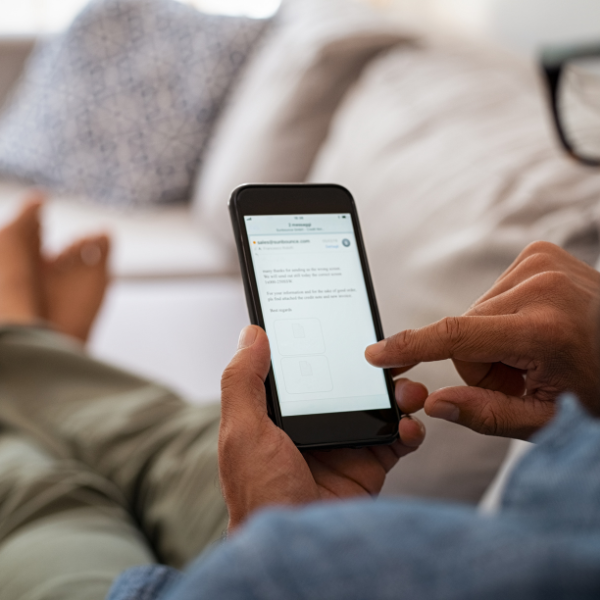
You likely have a constant barrage of emails lighting up your notifications, many you might even delete without glancing at the contents. With all these companies and organizations competing to be noticed in inboxes, is nonprofit email marketing even worth the effort?
We sure think so!
But, just like any tool, you need to know how to use it. In this blog, we cover exactly why we see email marketing as a must-do for nonprofit organizations. Plus, we give you a crash course in nonprofit email marketing best practices.
Why Email Marketing is a Must for Nonprofits
First, let’s look at the numbers. With average open rates sitting around 40% and click rates at more than 3.25%, nonprofit organizations tend to see some of the best email engagement when compared to other industries. If you ask us, that makes it a pretty essential tool!
Plus, it’s what your donors want. Email has been found to be the preferred method of contact for people who interact with nonprofits – 48% have said it’s their ideal way to receive updates and appeals and 26% of donors cite emails as the tool that most inspires them to give.
Not only that, but email is one of the most budget-friendly forms of communications you have at your fingertips. While the cost depends on your email marketing software, you’ll typically pay for the size of your list or number of contacts. But you won’t have ad placement, print, or mailing costs as you will with other outreach methods.
Email also makes it easy to target a very specific audience. With segmentation, you can be sure your message is getting in front of the intended recipient.
You can also track a lot of data with email marketing, including open rates, click rates, bounce rates, unsubscribe rates, and more. This level of detail enables you to easily test different messages, ensuring you’re resonating with your audience.
Finally, nonprofit email marketing is also relatively quick. While writing, designing, and sending an appeal letter can take weeks from conception to mailbox, you could write, build, and send an email in a matter of minutes. This makes email particularly vital in urgent situations, such as emergency fundraising or last-minute pushes to hit a campaign goal.
10 Nonprofit Email Marketing Best Practices
Now that you know why email marketing is essential to nonprofits, let’s take a look at a few best practices to help you get started.
When to Send Nonprofit Emails
You could write the best email ever, but it won’t matter if no one sees it. So when should you send your nonprofit marketing emails to ensure they are both read and clicked?
The answer is whenever your contacts are most likely to open and engage with them!
1. Start with the industry standard for optimum send times.
If you’re just getting started with nonprofit email marketing, take a look at what others are doing in your industry.
It’s long been an email marketing standard that weekdays – specifically Tuesday, Wednesday, and Thursday – are the best days for email engagement. This continues to hold true for most nonprofits as well as for-profit businesses.
As for timing, most sources agree that mid-morning (around 10 a.m.) on these weekdays is prime time, with a few sources discovering that a mid-afternoon send time can also be effective.

2. Find what timing works best for your audience.
But! It’s important to make adjustments to fit your audience. While some demographics may follow standard email engagement patterns, others simply won’t.
Don’t be afraid to try different send days and times, noting open rates and click rates. Over time, you’ll be able to see a pattern, giving you an ideal sending window customized to your audience and their preferences.
3. Determine your email frequency.
When testing for email timing, also test for email frequency. You want to email your audience often enough that you remain top of mind, but not so often that you become just another annoying email in their ever-growing inbox.
For many organizations, this sweet spot lies somewhere between once a month and once a week. But every audience is different!
You should also plan to have increased email frequency during select times, such as fundraising campaigns or in the lead-up to a major event.
Tip from the Playbook: Invest in an email marketing software! There are several affordable options out there to save you time and stress. These tools enable you to not just build eye-catching messages with ease, but also schedule your emails as well as access important data.
Top Nonprofit Email Audience Tips
Your nonprofit email marketing strategy is only as good as your email audience! Here are a few best practices to help you form a strong contact list.
4. Build a quality nonprofit email marketing list.
While it may be tempting to build the biggest possible email list, quality is better than quantity in this case.
A quality list is one filled with contacts who want to hear from you. To create one, follow these tips:
- Only send to contacts who have given you permission to email them. This may be through donating, attending an event, or volunteering with your organization. Or, they might sign up via a contact form. Be sure to check email permission requirements in your area to avoid having your account shut down.
- Create an easy-to-use email sign-up form. Make your form easily accessible on your website and quick to fill out. You should only be asking for name and email – more than that and you risk losing out on a lot of potential contacts.
- Clean up your list. Improve the deliverability of your emails by keeping your list in tip-top shape. Remove anyone who has not opened and/or engaged with an email after a set amount of time. And make it easy to unsubscribe in every email!
5. Segment your email audience.
While it may be tempting to send every email to your entire list, it’s almost never the best course of action.
Remember, the same message won’t resonate with everyone. And your contacts may stop opening your emails if they don’t feel the contents apply to them.
Break your contacts down into separate, easy-to-use lists or tags that make segmenting and targeting different demographics a breeze. If you’re feeling overwhelmed, start with a few segments and build from there.
Here are a few basic segments your nonprofit may be able to use:
- Donors – Anyone who has given to your organization.
- Volunteers – Contacts who have volunteered for your nonprofit in some way.
- Beneficiaries – Those who have received your organization’s services or have participated in your programs.
As you get the hang of it, try building more precise segments. The more specific you can get with your messaging, the better! For example, your “Donors” segment could be broken into several sub-segments, including LYBUNT (Last Year But Unfortunately Not This), Major Donors, Monthly Donors, First-Time Donors, and more.
MVP Playbook Resource: Creating target personas using this free worksheet can help with donor segmentation and outreach.
How to Develop Engaging Nonprofit Email Marketing Content
6. Personalize your messages.
Your supporters want to feel as if you are talking to them…and only them. An easy way to personalize is by using their preferred name in the greeting (no more “Dear Donor,” or “Hi, Friend!”).
This is also where all of that segmentation comes in! Craft personalized messages that are specific to your segments to ensure you are speaking directly to them, while sticking to your nonprofit’s brand voice and tone.
Reaching out to lapsed donors who haven’t given in a couple years? Mention that. Asking annual donors to up their support with a monthly gift? Talk about how it will make a lasting impact.

Segmentation will also keep you from sending messages you don’t want some segments to see, such as sending a fundraising email to the beneficiaries who may not be able to give back.
Tip from the Playbook: You don’t have to recreate the wheel to write great email content for each of your segments. Start by simply crafting a general message with all of your key points included. Then, adjust here and there to fit each of your intended audiences.
7. Focus on your email subject lines.
Having a unique and eye-catching subject line is a must in nonprofit email marketing. The key is to give just enough away about what’s in the email to spark interest, but not so much that the reader doesn’t need to open to learn more. Adding in an appropriate emoji (we recommend sticking to one) can also help draw the eye.
Whenever possible, your subject line should also have a sense of urgency – why should your contacts open this email right now? And an emotional tug at the heart strings can help, too, particularly for fundraising appeals.
Just be sure that your subject line is honest about what’s inside the email. Don’t create false urgency or use language that could come across as spam.
Shorter subject lines also tend to perform better. If it’s too long, your contacts’ email provider may cut it off, especially on mobile. Think around nine to 11 words or less.
8. Include a call to action in every email.
Picture this: a contact who is in your intended audience has opened your email. They have read the entire thing. But now they don’t know what you want them to do. Do you want them to give online? Buy event tickets? Sign up to participate in a program?
It’s critical that you include a call to action in your nonprofit emails. Otherwise, your audience won’t understand the purpose behind your outreach.
The action could be a soft ask, such as directing the audience to read more about a story on the blog or watching a thank-you video. Or, you could directly ask for donations, volunteer sign-ups, or ticket purchases.
Either way, be sure to spell it out at least once in your email to boost engagement and see results.
9. Sign it!
People typically respond better to people, especially in the world of nonprofits. So, it’s a nonprofit email marketing best practice to send emails as a person, not an organization.
Signing your emails from a well-known staff member in your organization – often an executive director – is a personal touch that can go a long way. You can also edit the “Sender” to come from the signer instead of your entire nonprofit.
10. Test, test, and test again.
As we mentioned before, every nonprofit is unique and every audience is different. That’s why our final best practice for nonprofit email marketing is to keep testing anything and everything you can in regards to the contents of your emails.
Try out different subject lines, email senders, layouts, images, and more. Test to see if your audience tends to engage better with text-heavy emails or those with a limited number of words. Do they tend to click on buttons more? Or linked text within the body?
Most email marketing software programs allow for A/B testing, making these experiments easy. You can also review key data points, like open rates and click rates, over time to see what works best.
The goal is to find the email solution that’s right for your team, your nonprofit, and your audience.
Get Ready, Get Set, Send!
Guess what? You’ve passed Nonprofit Email Marketing 101! Congratulations!
You’re well on your way to producing quality emails for your organization that stand out in the inbox.
If you’re looking for more digital marketing tips, check out our Social Media for Nonprofits blog here.
And if you’re looking for a group of consultants ready to help with your nonprofit email marketing strategy – and beyond – the team at MVP Advisors is here for you! We’ve got decades of experience in everything from strategic planning and market research to donor prospecting and content development. Email us or set up a call today to get started.
